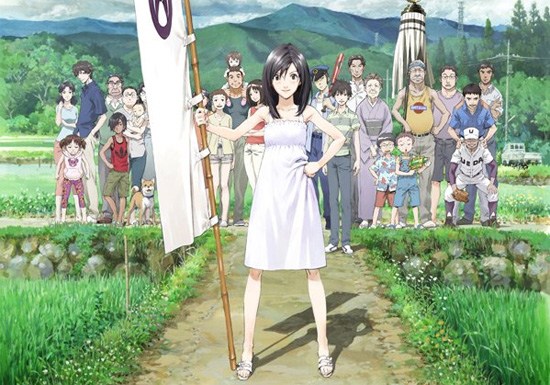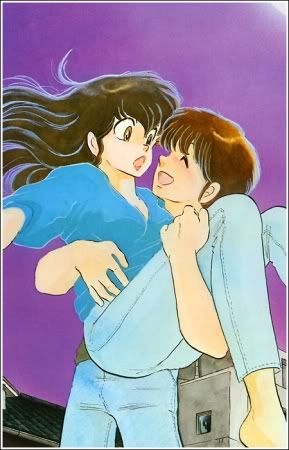FLCL

This madcap rock n' roll OVA adventure features just about everything good about anime. It features gorgeous animation (courtesy of GAINAX and Production I.G.), first-rate humor, Inception-level surrealism, interesting characters, and a solid story to boot. The dub emulates the original japanese almost exactly, down to the last a-re. The performances suffer from this a bit at first, but about 5 minutes into the first episode, the voice actors get really into the story, leading to a faithful adaption completely equal to what came before. FLCL can be found streaming subtitled in its entirety on
Funimation.
ONE PIECE

While I prefer the manga, the One Piece anime is a perfect hook for a new fan for the lack of that "IT GETS GOOD AT Vol. 9" mentality that comes with the manga, and a glorious Saturday morning cartoon feel that makes the show great for casual watching, despite the daunting 500+ episode count. The Funimation dub (avoid the 4kids version) perfectly reproduces that Loony Tunes aesthetic, and even dubs the theme song! One Piece is streaming in both formats on
Funimation, with new subbed episodes weekly.
MOBILE SUIT GUNDAM (Original)

As I mentioned last week, Giant Robot anime is awesome. While not the "first" or "best" Giant Robot anime, the Gundam franchise has defined the genre for decades. The original is a little dated, but in that lies its charm, as well as a way to justify Yoshiyuki Tomino's sloppy storytelling. The show is currently only available here in dub, but the dub is good, and a subbed edition is due out on DVD later this year. The whole thing (save one mysteriously absent episode mid-series) is streaming dubbed via
Crunchyroll.
SUMMER WARS

This fun new film from Mamoru Hosoda and Madhouse features a one-two punch of flashy fight scenes and involving family drama. It could be better, but it is very good. When I saw this movie, I was reminded of the recent Scott Pilgrim movie. Edgar Wright described the film as a "fightsical", like a musical, but instead of breaking into song at an important moment, the characters break into fights. Summer Wars is similar in this way, but without the strong emphasis on fight scenes that often detracted from the main plot of SP. Kids will enjoy Summer Wars, though they may not understand everything. The dub by Funimation (who, as you can tell by this article, are a big presence in R1 anime) is stellar, highly watchable, and easy to understand despite many culturally specific moments. Not streaming.
THE WORKS OF SATOSHI KON

Satoshi Kon is an amazing director. His movies can be dark, whimsical, cutting edge, sophisticated, or entertaining, and usually all of these at the same time. Perfect Blue is easily the scariest movie I've ever watched. Few movies will ever be able to the whimsical grace of Millenium Actress. Tokyo Godfathers is an incredibly fun film to watch, and makes the Christmas spirit actually seem genuine for once. And Paprika captured all those emotions and combined them into a gorgeous, elaborate love letter to cinema. Several of these movies have been dubbed, but the only professional-standard dubs (i.e. not by some office workers at Manga UK) are Paprika, and his TV series Paranoia Agent, unseen by this reviewer. Anyway, his works are very Japanese, so I strongly suggest watching them subtitled.
Not streaming.
GHOST IN THE SHELL

I've always found it hard to believe that Mamoru Oshii's cyberpunk masterpiece Ghost In The Shell was so successful in America. While the fact that it inspired The Matrix certainly generated a lot of attention, I can only think of one reason Ghost in the Shell could be so popular: America has a
lot of hipsters. Based on the vastly inferior manga by Masamune Shirow, Ghost in the Shell is set in a hypothetical future world where most people have had their bodies replaced with cyborg technology, and are linked in cyberspace. Motoko Kusanagi and the rest of the Section 9, a covert operations division of the Japanese Police, are tasked with finding the "Puppet Master", a mysterious entity hacking into peoples bodies. Throughout the movie, elaborate philosophical questions are raised about humanity and technology. If you have ignored anime in the past because it was not "serious" art, be sure to take a look at Ghost in the Shell. And for those who don't like Japanese voices, the dub is very good. Streaming dubbed on
Netflix.
LAPUTA: CASTLE IN THE SKY

Hayao Miyazaki is the most widely recognized anime director outside of fan circles, and for a good reason: His movies are amazing! Castle in the Sky was his first feature film created as a Studio Ghibli production, and possibly his best. This is old school escapism at its best: The young hero. The mysterious girl. The dastardly villain. The lost kingdom. The epic adventure. All of this and more in this amazing movie! Castle in the Sky was adapted into english by none other than John Lasseter of Pixar fame and produced by Disney, featuring A-list actors such as Mark Hamill and Mandy Patinkin. Not streaming, obviously.
COWBOY BEBOP

Funky, jazzy, and slick, Cowboy Bebop was the first anime many people watched, and the all-time favorite of many more. In a future where space is so heavily colonized that no government can even hope to manage crime, hopeful bounty hunters dreaming of wealth pursue criminals across the stars. This is the story of the bounty hunters on the ship Bebop, and their various adventures. Though the concept sounds straightforward, Series Director Shinichiro Watanabe and Composer Yoko Kanno infuse the story with a distinctive style incorporating elements of western, film noir, jazz, and, of course, bebop. The show was dubbed, though it's much better in Japanese. Not streaming.
FULL METAL ALCHEMIST

Based on the very good manga by Hiromu Arakawa, the Full Metal Alchemist anime takes the manga's story of two brothers searching for the philosopher's stone in a wildly divergent direction. Featuring great animation from BONES and even better world building than in the manga, FMA is great for new fans and jaded mangaphiles alike. While I never liked any of the dub (except for the movie), it has been hailed by many as one of the best of its kind. Streaming in both formats on
Funimation.
EDEN OF THE EAST

Eden of The East may be a non-anime fan's best option on this list, and it is only a year old. Akira Takizawa's journey to find his lost memories has more than a whiff of Bourne Identity-style thriller, but at its heart, the story is as much about Akira as it is about his friend Saki Morimi, and their relationship provides the series' emotional core. Indeed, this show feels far less like director Kenji Kamiyama's previous series, a TV spin-off of Ghost in the Shell, and more like character designer Chika Umino's josei manga/anime, Honey and Clover. The series is heavily flawed in places, but for the most part, Kamiyama's attempts at telling a fresh story pay off big time. For the dub, Funimation turns out a solid production as always. Streams have been taken down (oh well).






![Maison Ikkoku Manga (v.5, ch.4, p.29)
[Click to view next page or press next or back buttons] Maison Ikkoku Manga (v.5, ch.4, p.29)
[Click to view next page or press next or back buttons]](http://www.anymanga.com/manga/maison-ikkoku/005/004/029.png)

















